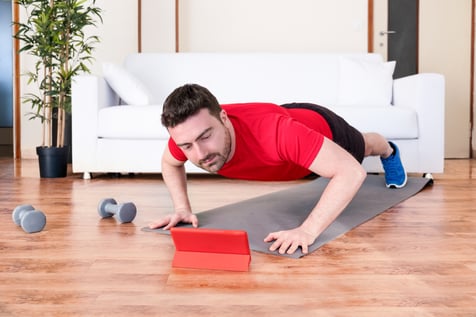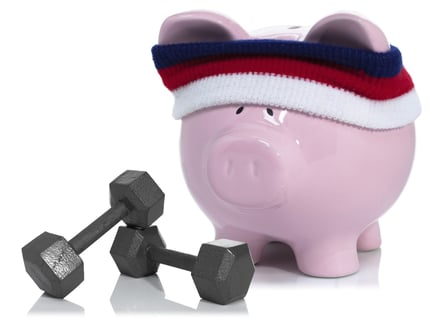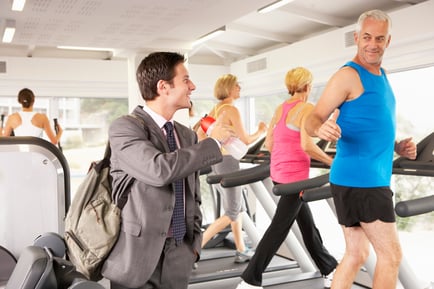 Are your fitness and wellness programs reaching your residents, but now you’re wondering how to take your community’s reputation to the next level by demonstrating an even bigger commitment to a healthy, active lifestyle campus-wide? Perhaps it’s time to incorporate a staff component into some of your resident fitness and wellness initiatives! There are several benefits of employees participating in challenges or broader wellness initiatives with residents in your community settings, here are the top 5!
Are your fitness and wellness programs reaching your residents, but now you’re wondering how to take your community’s reputation to the next level by demonstrating an even bigger commitment to a healthy, active lifestyle campus-wide? Perhaps it’s time to incorporate a staff component into some of your resident fitness and wellness initiatives! There are several benefits of employees participating in challenges or broader wellness initiatives with residents in your community settings, here are the top 5!
- Improved Health and Wellness: Regular physical activity is not only beneficial for your residents, but for everyone! By participating in resident fitness and wellness challenges employees too can maintain a healthy weight, reduce their risk of disease, improve their strength, flexibility, and cardiovascular health, and improve their overall health and well-being. By participating alongside residents, they’re also more likely to stick to their goals as they become role models, supporters, and more accountable.
- Team Building: You want a strong collaborative team leading of employees leading the way at your community, right? By including employees into fitness and wellness challenges and encouraging them to work together towards a common goal, you’ll be fostering team building, collaborative programming, communication, and a sense of community which can be beneficial for them in all aspects of their lives, including at work.
- Enhanced Job Satisfaction: When employees can participate in activities which promote better well-being, they’re likely to experience increased energy levels, decreased stress, improved mood and greater job satisfaction. Increased job satisfaction and morale can lead to greater productivity, and increased employee retention!
- Positive Impact of Resident Experience: Participating in a challenge alongside one another can foster positive relationships between employees and residents. This provides them with the ability to build rapport with each other and leads to better communication, and enhanced employee-resident interactions. When your residents see that the employees are engaged and committed to healthy habits through participation more residents may be inclined to join in as well, which can improve their health and fitness outcomes and enhance their overall quality of life.
- Positive Reputation and Retention: By demonstrating a commitment to employee health and well-being, while continuing to promote vibrant lifestyle options for your residents, you will be more apt to attract and retain not only residents, but also a top performing team!
If you wish to have a productive workplace environment and retain top talent, we urge you to open some aspect of your community-wide wellness initiatives to your employees.


.jpg?width=458&height=305&name=GettyImages-805085582%20(1).jpg) What Makes Cycle So Great?
What Makes Cycle So Great?
 THE BRAIN: the most important organ in our body, is often the most forgotten when we think of training. Why does the brain always seem to slip through the cracks? We can’t stop talking about BMI, body fat percentage, heart rate reserve, and all these other buzz words in the fitness industry. Now you’re probably thinking “but isn’t exercise good for the brain?” and you’d be right but there is more to it than that. We aren’t specifically targeting our brain, we’re focused on our muscles, our heart and the brain is just getting a splash of the love it deserves. That’s something I’d like to change! And we can do that in the gym and at home.
THE BRAIN: the most important organ in our body, is often the most forgotten when we think of training. Why does the brain always seem to slip through the cracks? We can’t stop talking about BMI, body fat percentage, heart rate reserve, and all these other buzz words in the fitness industry. Now you’re probably thinking “but isn’t exercise good for the brain?” and you’d be right but there is more to it than that. We aren’t specifically targeting our brain, we’re focused on our muscles, our heart and the brain is just getting a splash of the love it deserves. That’s something I’d like to change! And we can do that in the gym and at home. The holidays are fast approaching and as we strive to help our corporate fitness members Maintain and Not Gain this season. Follow these tips and strategies to avoid tipping the scale or adding a notch to the belt over the next few weeks.
The holidays are fast approaching and as we strive to help our corporate fitness members Maintain and Not Gain this season. Follow these tips and strategies to avoid tipping the scale or adding a notch to the belt over the next few weeks. 
 While many have come to appreciate the convenience of working at home, the impact it can create on a sense of routine is far-reaching. When you head into the office for the day, it can be easier to honor that me-time in your schedule to squeeze in a group fitness class or work out in the onsite fitness center. When you are working from home, the distractions of the dishes in the sink, laundry in the dryer, and kids trying to complete homework can compete for those precious spare minutes of downtime you have between meetings and work obligations.
While many have come to appreciate the convenience of working at home, the impact it can create on a sense of routine is far-reaching. When you head into the office for the day, it can be easier to honor that me-time in your schedule to squeeze in a group fitness class or work out in the onsite fitness center. When you are working from home, the distractions of the dishes in the sink, laundry in the dryer, and kids trying to complete homework can compete for those precious spare minutes of downtime you have between meetings and work obligations. 
.jpg?width=393&name=GettyImages-873616226%20(1).jpg) Corporate fitness centers are pretty low on the totem pole for most organizations. And that's how they end up just "existing" with the rest of the benefit items; they're on the list of nice things to have, but there's nothing about the corporate fitness program itself that tells leadership it's really thriving or performing well for the employees. If that resonates with you and what you're seeing in your worksite fitness program, it might be time to change things up.
Corporate fitness centers are pretty low on the totem pole for most organizations. And that's how they end up just "existing" with the rest of the benefit items; they're on the list of nice things to have, but there's nothing about the corporate fitness program itself that tells leadership it's really thriving or performing well for the employees. If that resonates with you and what you're seeing in your worksite fitness program, it might be time to change things up.
 There’s a lot of misinformation out there on what is and is not good for you. The science changes all the time; unfortunately, changes in health information can
There’s a lot of misinformation out there on what is and is not good for you. The science changes all the time; unfortunately, changes in health information can 
 What’s better than chips and guacamole? Tacos and guacamole? Fajitas and guacamole? Or guacamole and a serving of guacamole with a little dish of guacamole on the side? Point is guacamole is amazing and what better way to celebrate the awesomeness of guacamole than Cinco de Mayo. If you plan on indulging in as much guacamole as I do this Cinco de Mayo then maybe a plyometric workout beforehand will keep your conscience at bay when asking your waiter/waitress for that third serving of guac. Here are my 5 favorite plyometric exercises for Cinco de Mayo:
What’s better than chips and guacamole? Tacos and guacamole? Fajitas and guacamole? Or guacamole and a serving of guacamole with a little dish of guacamole on the side? Point is guacamole is amazing and what better way to celebrate the awesomeness of guacamole than Cinco de Mayo. If you plan on indulging in as much guacamole as I do this Cinco de Mayo then maybe a plyometric workout beforehand will keep your conscience at bay when asking your waiter/waitress for that third serving of guac. Here are my 5 favorite plyometric exercises for Cinco de Mayo:


 As you kick off the New Year in your workplace, you will probably overhear many of your employees talking about being healthier this year, and their New Year’s resolutions. Eating better, participating in more physical activity, stressing less, establishing a better work-life balance… the list goes on. If your workforce is like the majority of people who have the best intentions of improving their health this year, many will be unsuccessful once work and life get back in the way.
As you kick off the New Year in your workplace, you will probably overhear many of your employees talking about being healthier this year, and their New Year’s resolutions. Eating better, participating in more physical activity, stressing less, establishing a better work-life balance… the list goes on. If your workforce is like the majority of people who have the best intentions of improving their health this year, many will be unsuccessful once work and life get back in the way.